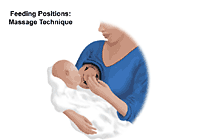What are plugged milk ducts?
A plugged duct feels like a tender lump in the breast. Some mothers seem to be more prone to developing them. Usually they happen when a mother goes too long without emptying her breasts. Or, if insufficient milk is removed during feedings.
What can be done
Review your baby's feeding routine and see if the time between one or more feedings or pumping sessions has recently changed for any reason. Sometimes, a mother gets busy with a task and does not realize feedings or pumping sessions are being delayed. The way the baby is sucking may also contribute to plugged ducts. Sometimes the baby's latch needs to be evaluated by a lactation consultant. Also, check that the material of nursing bras or clothing bunched during feedings is not putting pressure on milk ducts in a certain area of the breast.
If you develop a plugged duct, be sure to breastfeed or remove milk often and alternate different feeding positions. Do not stop breastfeeding. This will make the problem worse. It often helps to apply warm compresses to the area or soak the breast in warm water while massaging the lump. Massage above and then over the affected area when breastfeeding or pumping as well.
Many women can take over-the-counter pain medicines like ibuprofen or acetaminophen to help with the pain. Ask your healthcare provider first.
When to seek help
If the lump does not go away over the course of a couple of days, contact your healthcare provider. Also, if you feel ill, develop a fever or chills, or the area around the lump begins to look red, you need to contact your healthcare provider immediately. This could be a sign that you have an infection (mastitis) and might need to take antibiotics.











